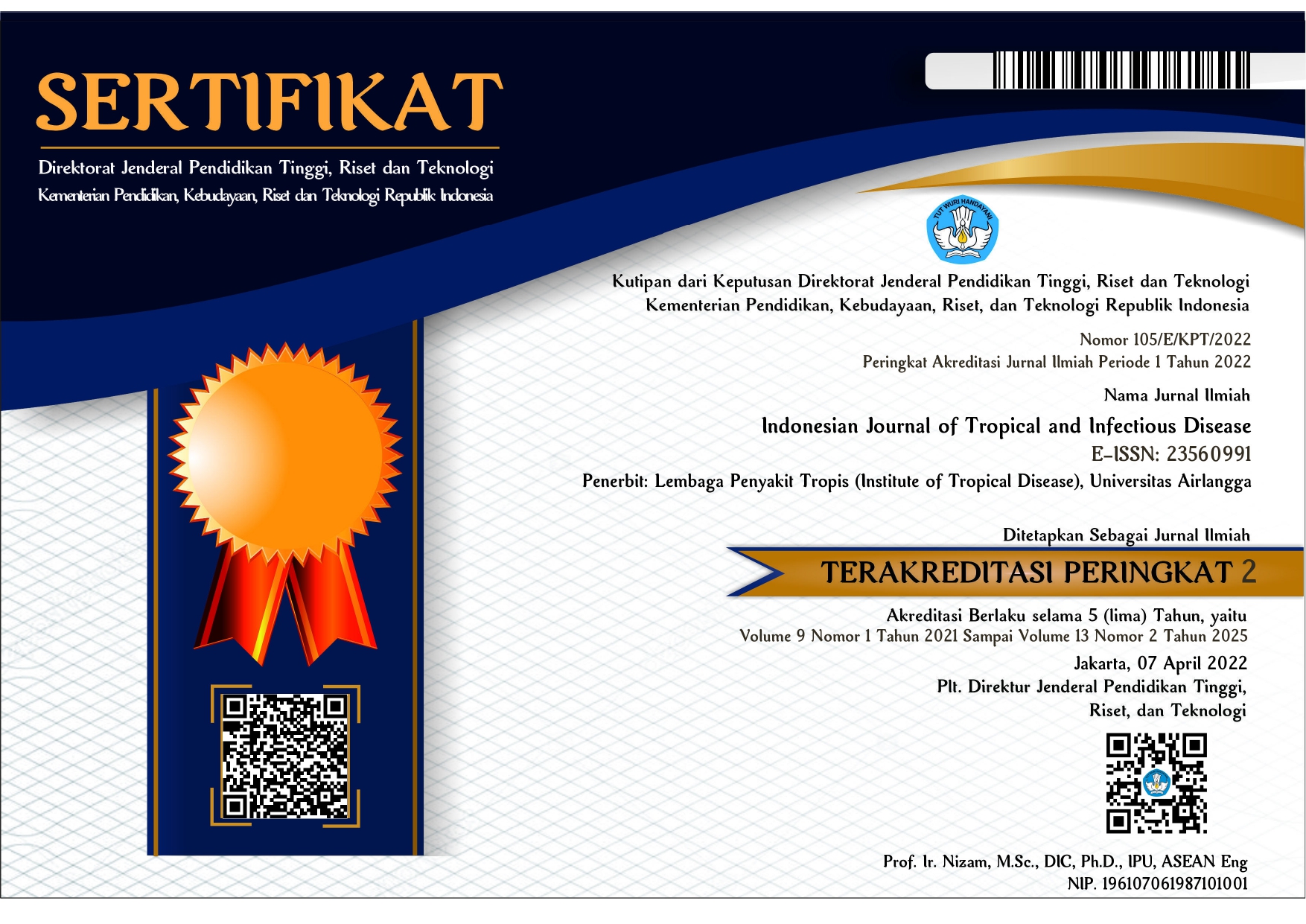Purple Urine Bag Syndrome: a Rare Manifestation of Urinary Tract Infection
Downloads
Purple urine bag syndrome (PUBS) is rare manifestation of urinary tract infection (UTI). Epidemiological study showed the prevalence of purple urine bag syndrome about 8.3%-16.7% worldwide. There are some factors which lead to the disease including female, long-term urinary catheter, bedridden or immobile for long time, constipation, and urinary tract infection. The mechanism of this condition involves the tryptophan in intestine that is degraded into indole. In the liver, indole is conjugated into indoxyl sulphate. This conjugate product then is excreted into urine by the kidney. In the infected urinary tract, some gram-negative bacteria produce enzymes called sulphatase and phosphatase. It converts the conjugated product, indoxyl sulphate into pigments, red indirubin and blue indigo. The two pigments-combination produces purple pigment which appears in urine. We present a-61-year-old female who has history of cerebrovascular accident who came to our emergency room with purple urine over the previous seven days.
Kalsi DS, Ward J, Lee R, Handa A. Purple Urine Bag Syndrome: A Rare Spot Diagnosis. Vol. 2017, Disease Markers. Hindawi Limited; 2017.
Neniwal VK, Swain S, Rulaniya SK, Hota D, Agarwal P, Yadav PK. Purple urine bag syndrome: An unusual manifestation of urinary tract infection, our experience at a tertiary care center. Curr Urol. 2023 Jun 1; 17(2):125–9.
Kumar U, Singh A, Thami G, Agrawal N. Purple urine bag syndrome:A simple and rare spot diagnosis in Uroscopic rainbow. Urol Case Rep. 2021 Mar 1;35:101533
Sabanis N, Paschou E, Papanikolaou P, Zagkotsis G. Purple Urine Bag Syndrome: More Than Eyes Can See. Curr Urol. 2019 Nov 18; 13(3):125–32.
Yang HW, Su YJ. Trends in the epidemiology of purple urine bag syndrome: A systematic review. Vol. 8, Biomedical Reports. Spandidos Publications; 2018. p. 249–56.
Worku DA. Purple urine bag syndrome: An unusual but important manifestation of urinary tract infection. Case report and literature review. SAGE Open Med Case Rep. 2019 Jan;7:2050313X1882310.
Ywe W, Wong YWE AN, Wong Yi Wah E, Abdullah N. Purple urine bag syndrome: A startling phenomenon of purple urine in a urine drainage bag. A primary care approach and literature review. Vol. 13, Malaysian Family Physician. 2018.
al Montasir A, al Mustaque A. Purple urine bag syndrome. J Family Med Prim Care [Internet]. 2013; 2(1):104. Available from: https://journals.lww.com/10.4103/2249-4863.109970
Traynor BP, Pomeroy E, Niall D. Purple urine bag syndrome: A case report and review of the literature. Oxf Med Case Reports. 2017 Nov 1; 2017(11):215–7.
Yaqub S, Mohkum S, Mukhtar KN. Purple urine bag syndrome: A case report and review of literature. Indian J Nephrol. 2013 Mar; 23(2):140–2.
Llenas-García J, García-López M, Pérez-Bernabeu A, Cepeda JM, Wikman-Jorgensen P. Purple urine bag syndrome: A systematic review with meta-analysis. Eur Geriatr Med. 2017 Jul 1; 8(3):221–7.
Pandey S, Pandey T, Sharma A, Sankhwar S. Purple urinary bag syndrome: What every primary healthcare provider should know. Vol. 2018, BMJ Case Reports. BMJ Publishing Group; 2018.
Castanheira M, Simner PJ, Bradford PA. Extended-spectrum β-lactamases: An update on their characteristics, epidemiology and detection. Vol. 3, JAC-Antimicrobial Resistance. Oxford University Press; 2021.
Vachvanichsanong P, McNeil EB, Dissaneewate P. Extended-spectrum beta-lactamase Escherichia coli and Klebsiella pneumoniae urinary tract infections. Epidemiol Infect. 2020.
Larramendy S, Deglaire V, Dusollier P, Fournier JP, Caillon J, Beaudeau F, et al. Risk factors of extended-spectrum beta-lactamases-producing escherichia coli community acquired urinary tract infections: A systematic review. Vol. 13, Infection and Drug Resistance. Dove Medical Press Ltd; 2020. p. 3945–55.
Copyright (c) 2024 Indonesian Journal of Tropical and Infectious Disease

This work is licensed under a Creative Commons Attribution-NonCommercial-ShareAlike 4.0 International License.
The Indonesian Journal of Tropical and Infectious Disease (IJTID) is a scientific peer-reviewed journal freely available to be accessed, downloaded, and used for research. All articles published in the IJTID are licensed under the Creative Commons Attribution-NonCommercial-ShareAlike 4.0 International License, which is under the following terms:
Attribution ” You must give appropriate credit, link to the license, and indicate if changes were made. You may do so reasonably, but not in any way that suggests the licensor endorses you or your use.
NonCommercial ” You may not use the material for commercial purposes.
ShareAlike ” If you remix, transform, or build upon the material, you must distribute your contributions under the same license as the original.
No additional restrictions ” You may not apply legal terms or technological measures that legally restrict others from doing anything the license permits.























